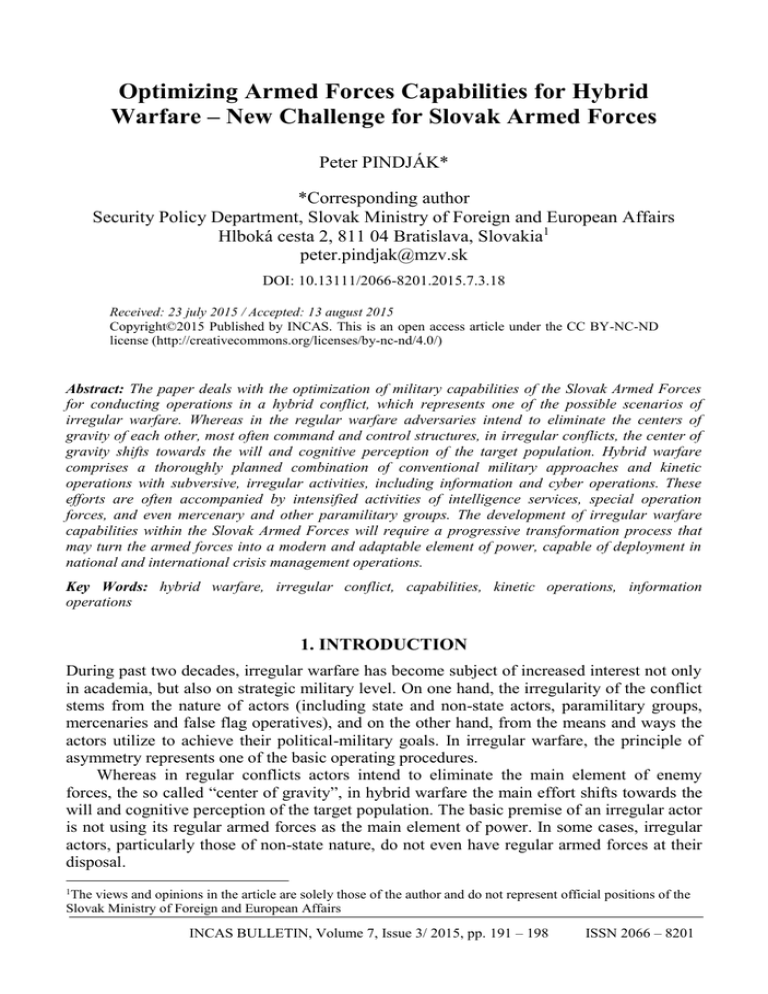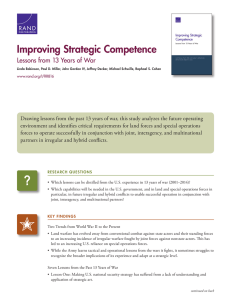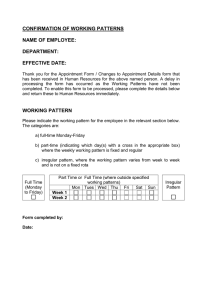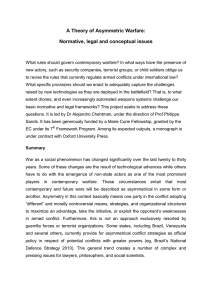Optimizing Armed Forces Capabilities for Hybrid
advertisement

Optimizing Armed Forces Capabilities for Hybrid Warfare – New Challenge for Slovak Armed Forces Peter PINDJÁK* *Corresponding author Security Policy Department, Slovak Ministry of Foreign and European Affairs Hlboká cesta 2, 811 04 Bratislava, Slovakia1 peter.pindjak@mzv.sk DOI: 10.13111/2066-8201.2015.7.3.18 Received: 23 july 2015 / Accepted: 13 august 2015 Copyright©2015 Published by INCAS. This is an open access article under the CC BY-NC-ND license (http://creativecommons.org/licenses/by-nc-nd/4.0/) Abstract: The paper deals with the optimization of military capabilities of the Slovak Armed Forces for conducting operations in a hybrid conflict, which represents one of the possible scenarios of irregular warfare. Whereas in the regular warfare adversaries intend to eliminate the centers of gravity of each other, most often command and control structures, in irregular conflicts, the center of gravity shifts towards the will and cognitive perception of the target population. Hybrid warfare comprises a thoroughly planned combination of conventional military approaches and kinetic operations with subversive, irregular activities, including information and cyber operations. These efforts are often accompanied by intensified activities of intelligence services, special operation forces, and even mercenary and other paramilitary groups. The development of irregular warfare capabilities within the Slovak Armed Forces will require a progressive transformation process that may turn the armed forces into a modern and adaptable element of power, capable of deployment in national and international crisis management operations. Key Words: hybrid warfare, irregular conflict, capabilities, kinetic operations, information operations 1. INTRODUCTION During past two decades, irregular warfare has become subject of increased interest not only in academia, but also on strategic military level. On one hand, the irregularity of the conflict stems from the nature of actors (including state and non-state actors, paramilitary groups, mercenaries and false flag operatives), and on the other hand, from the means and ways the actors utilize to achieve their political-military goals. In irregular warfare, the principle of asymmetry represents one of the basic operating procedures. Whereas in regular conflicts actors intend to eliminate the main element of enemy forces, the so called “center of gravity”, in hybrid warfare the main effort shifts towards the will and cognitive perception of the target population. The basic premise of an irregular actor is not using its regular armed forces as the main element of power. In some cases, irregular actors, particularly those of non-state nature, do not even have regular armed forces at their disposal. 1The views and opinions in the article are solely those of the author and do not represent official positions of the Slovak Ministry of Foreign and European Affairs INCAS BULLETIN, Volume 7, Issue 3/ 2015, pp. 191 – 198 ISSN 2066 – 8201 Peter PINDJÁK 192 Hybrid conflicts usually involve state actors, although they use conventional armed forces only marginally, preferably at the final stages of the conflict. Hybrid warfare comprises a carefully planned combination of conventional military action and kinetic operations divisive, irregular activities, including information and cyber operations. These efforts are often accompanied by intensified activities of intelligence and special operations forces, or mercenary and other paramilitary groups. Throughout past two decades, the Armed Forces of the Slovak Republic (AF SR) have undergone a gradual transformation that intended to turn them into a modern, well-trained and well-equipped force deployable in coalition operations, usually under the colors of international organizations. After the accession of the Slovak Republic in the European Union (EU) and North Atlantic Treaty Organization (NATO), the AF SR continued in implementing the transformation process, focusing mainly on building-up military capabilities useful for multinational operations led well beyond Slovak borders. Conducting combat operations in the ISAF mission in Afghanistan accounted for an important milestone for the AF SR, particularly through direct involvement in irregular armed conflict, in which the adversary constituted a non-state actor. Recent security developments in Eastern Ukraine as well as Russia's aggressive behavior have yet again drawn attention to the European continent and pointed to threats and risks that challenge fundamental principles and values of peaceful coexistence. The violation of territorial integrity, the outbreak of an irregular armed conflict on the territory of Europe and the rise of global terrorist movements in the Middle East pointed to the close link between internal and external security, as well as the growing need for solidarity and cohesion within the Euro-Atlantic community. While providing the security, stability and sustainable development of Europe, political leaders and military strategists once again acknowledged the irreplaceable role of territorial defense. In response to the situation in Eastern Ukraine, a number of countries in Central and Eastern Europe revised their national security and defense strategies. Changes in threat perception in Central and Eastern European region had so far no significant impact on the AF SR contributions to international crisis management operations. However, Slovakia, alike the neighboring countries within the Visegrad Group, initiated the process of revising its strategic security documents, including national security strategy dating back to 2005. It is expected that the new strategy will be adopted next year, after the endorsement of a revised European Security Strategy from 2003. There is a high likelihood that in the near future the AF SR will be adjusting its transformation efforts to effective deployment in a hybrid warfare scenario. The requirements for conducting irregular warfare have been already set in several doctrines of the AF SR as well as in the White Paper on Defense from 2013. These efforts are in line with the commitments of the Slovak Republic adopted at NATO Summit in Wales, including the Readiness Action Plan. In the end, the development of irregular warfare capabilities within the Slovak Armed Forces may turn the armed forces into a modern and adaptable element of power, capable of deployment in national and international crisis management operations. 2. FROM THEORY TO PRACTICE History of mankind has been interwoven with conflicts of various intensities and occurring on different societal levels. They were integral part of major revolutions, including those involving major breakthroughs in agriculture, industry, science and information and technology [1]. Conflict is a natural and inherent part of social life. “It expresses the heterogeneity of interests, values and beliefs” of the society [2]. INCAS BULLETIN, Volume 7, Issue 3/ 2015 193 Optimizing Armed Forces Capabilities for Hybrid Warfare – New Challenge for Slovak Armed Forces In terms of range of possible conflicts, they may be classified, in principle, as internal, international, and transnational. In the last two decades, substantial advances in information and communication technologies have led to an increase in conflicts that are characterized by asymmetry, whether in the composition of actors themselves or the ways and means they utilize to achieve their political-military goals. The September 11, 2001 terrorist attacks on the United States have fundamentally changed worldwide threat perception and ushered the Euro-Atlantic community into an era characterized by asymmetric warfare and fight against terrorist networks. Terrorism, which pursues political goals through methods of intimidation and acts of violence often directed at the civilian population, has become an increasingly popular choice of warfare, especially among non-state actors. This trend continues till today, especially in the context of the rise of terrorist movements and militant groups, including the so-called Islamic state (ISIL). Terrorism capitalizes on many trends of globalization, including access to advanced weapons and dual-use technologies, sophisticated communication systems and interconnected systems of financial services. A specific category of armed conflict, which has come to forefront in the last two decades and has become subject of a more detailed examination not only in academia but also on the strategic military level, is irregular conflict or “small wars.” The term “small wars” comes from the eponymous British study from 1896 authored by strategist Charles E. Callwell. He defines this type of conflict as “all other military campaigns than those, in which both sides consist of regular troops” [3]. In other words, small wars represent conflicts, in which at least one party does not use regular armed forces as its main element of power and does not conduct operations in conventional manner. Prussian military strategist Carl von Clausewitz defined armed conflict as “an act of violence, which intends to compel the enemy to submit to our will” [4]. This premise also holds for irregular conflicts, in which parties fight to win the hearts and minds of local people and influence the will of the target population, including through recognition of the legitimacy of the government in place. Most often, though not necessarily, irregular conflicts are asymmetric in nature. They usually feature special operations forces and other specialized units well suited for intelligence-related missions as well as clandestine and subversive operations. The objectives of such operations may include undermining relative quantitative and technological superiority of regular armed forces, instigating military deception, and demoralizing enemy through various methods. Hybrid warfare represents a specific type of irregular armed conflict. It has become subject of intense academic, military and political discussion, mainly due to security developments in Eastern Ukraine and the rise of the so called Islamic state (ISIL) in the Middle East. Although hybrid conflicts usually feature state actors, their use of conventional armed forces is limited. Regular armed forces are usually unveiled only at the final stages of the conflict. The concept of hybrid warfare was elaborated in detail by the Chief of Staff of the Armed Forces of the Russian Federation Valerij Gerasimov in his popular article from February 2013 [5]. According to Gerasimov the rules of war itself have changed. The role of non-military instruments for achieving political and strategic goals has substantially increased and in many cases exceeded the efficiency and importance of regular armed forces. Non-military tools are supplemented by military instruments of clandestine nature, including the use of Special Operations Forces, information operations and the deployment of troops without proper military insignia. Strategic political-military campaign utilizes holistic INCAS BULLETIN, Volume 7, Issue 3/ 2015 Peter PINDJÁK 194 approach in the effective deployment of civilian and military instruments, including those of political, economic, informational and humanitarian nature. Introduction of conventional military to conflict - often under the disguise of a “peacekeeping operation” - occurs only in the final stages of the conflict in order to prevail and achieve ultimate success. In the early stages of hybrid conflict, operations are conducted outside of the framework of conventional armed forces. However, these endeavors may be accompanied by the presence of conventional forces near the area of operations, for example as part of military exercises, as was the case of Russian troops near the border with Ukraine. Such military exercises conducted in the context irregular conflicts may have significant effect in the form of psychological pressure on political leaders and the population. The basic premise of hybrid warfare lies is undermining the unity, cohesion and integrity of the enemy through destabilization of the entire security sector and polarization of the society. The aggressor focuses on influential political leaders and state officials with decision-making powers, particularly through targeted information operations. These activities are accompanied by the stimulation of social unrests and sustenance of various separatist tendencies that raise doubts about territorial integrity and weaken the legitimacy of the government [6]. Hybrid conflicts also point to the increasing interconnectedness between internal and external security of the state and the associated importance of an integrated security system at the national level. Gerasimov divides hybrid conflict in six phases, in which military and non-military measures gradually evolve and assume their respective roles with targeted effects. Military conflict, featuring regular conventional armed forces, may be recognized only in the fifth phase. In the early stages, non-military instruments play the prime, including through information and psychological operations as well as diplomatic and economic measures aimed at creating a security vacuum that can be later on exploited by the enemy. These activities may also be accompanied by specialized actions and intelligence operations aimed at intimidation, propaganda, corruption activities, inciting desertion in the ranks of security forces and supporting leaders of paramilitary groups with the potential of forming resistance movements. When conventional forces are finally deployed, usually it is preceded by the establishment of a no-fly zone over the theatre of operations and the blockade of supplies of various goods and services in the area. This also creates conditions for a more intense involvement of militant groups in the conflict, including mercenaries of foreign nationality. The fifth phase of the hybrid conflict then features all forms of conventional and unconventional military instruments and capabilities, including Special Operations Forces and specialized units for conducting cyber operations. In the escalation process of military conflict, significant effects can be achieved through operations that deny or influence services in cyberspace and outer space [7]. In the last phase of the conflict, emphasis is placed on resolving the crisis through diplomatic channels, often looking for solutions to legitimize the crisis through the participation of international organizations. A good example provides the situation in Ukraine, where there are currently missions of both the OSCE and the EU in place. Since most hybrid threats are of civilian nature, credible deterrence and defense against hybrid threats requires effective coordination and cooperation between all national and international security actors, including NATO and the EU. In particular, it is important to deepen mutual cooperation in the area of communication strategy, analytical and intelligence activities and early warning of hybrid threats. INCAS BULLETIN, Volume 7, Issue 3/ 2015 195 Optimizing Armed Forces Capabilities for Hybrid Warfare – New Challenge for Slovak Armed Forces From the perspective of building and further developing military capabilities for effective deployment in hybrid conflict, it is important to focus on specialized areas such as intelligence and early warning, command and control, communications, information operations capabilities including PSYOPS, CIMIC, unexploded ordnance disposal (EOD), countering improvised explosive devices (C-IED), nuclear, biological and chemical protection (NBC), cyber capabilities (defensive and offensive measures), and Special Operations Forces (SOF). 3. HYBRID WARFARE AND THE SLOVAK ARMED FORCES The terms “irregular conflict” and “asymmetry” are present in several doctrines of the AF SR. Although the chief doctrine of the AF SR (C) of 2009 does not recognize the concept of irregular conflict, it elaborates on the concept of asymmetry. It is assumed that prospective NATO adversary will rarely employ conventional methods and approaches in achieving political-military objectives. The doctrine states that the enemy “will look for ways to eliminate the [military] superiority using unconventional means and methods of warfare, including through irregular and non-military forces, which are in violation of international law”. Asymmetric threats are evaluated in the following aspects: nature of the enemy, valuebased and cultural discrepancies and unconventional methods that can be used to resist the opponent qualitative and quantitative superiority. Military Doctrine of the Land Forces of the AF SR from 2010 already deals with the concept of irregular conflict, or the so called “small wars”. The doctrine tasks the land forces with maintaining readiness to conduct operations against an enemy of asymmetric nature, which uses irregular methods of warfare in a multinational environment. When defining the concept of asymmetry, it puts special emphasis on evaluating the nature and extent of asymmetry. It acknowledges that conflicts on land are rarely symmetrical. “The asymmetry may reflect differences in doctrines, composition of forces, culture, technology, and size”. The doctrine also calls for proactive expectation of asymmetry as well as continual process of finding new ways to eliminate asymmetric threats. These include, for instance, deceptive operations and the use of weapons of mass disruption such as chemical, biological and radiological substances. The Doctrine of the Air Force of the AF SR recognizes symmetrical and asymmetrical uses of aerial vehicles on selected targets. The effect of asymmetry can be employed, for instance, when attacking vulnerable positions in the enemy forces structure, for example the command and control, communication and intelligence positions [8]. From the doctrines of the AF SR that deal with irregular conflicts and the principle of asymmetry, it is the joint military doctrine - conducting operations against the insurgency (COIN) from 2011 that elaborates on the subject most extensively. The doctrine even introduces the concept of hybrid threats. It portrays them as an actor, which concurrently uses conventional and unconventional resources to achieve its objectives [9]. Within the doctrine, irregular conflict is discussed on the level of irregular activities. The doctrine defines them as “the use or threat of force by irregular forces, groups or individuals, who are often ideologically or criminally motivated, aimed at influencing or distracting changes planned or carried out by the government”. It further states that irregular threats can spread into all parts of the theatre of operations; they may be also supported by state and regional partners. These threats may assume the form of rebellion, terrorism, crime, riots and subversion. The doctrine states that counter-insurgency represents the most severe form of irregular INCAS BULLETIN, Volume 7, Issue 3/ 2015 Peter PINDJÁK 196 activities. In terms of asymmetry, it indicates that irregular actors often look for the use of asymmetric approaches to eliminate the universal superiority of conventional forces of the enemy. Besides the aforementioned doctrines, irregular conflict is also dealt with in the White Paper on Defense of the Slovak Republic from 2013. It assumes that future conflict, in which the AF SR will operate, “will be characterized by lack of support of the local population, a number of overlapping lines of conflict, without proper infrastructure and without functioning or underdeveloped legitimate authorities of the state or state institutions”. Furthermore, the White Paper foresees that the activities of the AF SR “will be conducted mainly against opponents employing irregular and asymmetric warfare, including the methods of terrorism”. It assigns high probability to conflicts of hybrid nature combining conventional and unconventional approaches at different stages of the conflict or simultaneously. One can expect that future transformation efforts of the AF SR, including the further development of military capabilities, will be largely driven by the trends in irregular warfare. 4. ADAPTING DEFENSE CAPABILITIES TO NEW TYPE OF CONFLICT Among defense capabilities that will turn out as increasingly important for the AF SR certainly belong those involving intelligence, surveillance and reconnaissance (ISR), Special Operations Forces (SOF), explosive ordnance disposal (EOD), protection against nuclear, biological and chemical attack (NBC), information operations including PSYOPS and civilmilitary cooperation (CIMIC). The new type of warfare also highlights the importance of the domains of cyberspace and outer space, which are becoming more integrated into the overall operational picture. “Space, including the use of space through sophisticated yet vulnerable architecture, has become subject of increased international cooperation, but also contest and rivalry. With an increasing number of actors capable of reaching orbit s the likelihood of abusing space for military purposes also increases”. Furthermore, “current technological trends as well as the security interests of dominant players in space demonstrate a growing risk, perhaps even the irreversibility, of arms race in space. Space has become an ever more relevant domain in military operations, especially for the unique capabilities enabled by orbital platforms” [10]. Although the AF SR have undergone two decades of transformation, their capabilities remain largely inadequate for effective deployment in international crisis management, including effective deployment in irregular conflicts. Only about half of military material and weapon systems of the AF SR are interoperable with those of allied forces. On the other hand, the AF SR have managed to earn reputation of a reliable and responsible partner among allies. Future modernization processes should not only be aimed at developing new capabilities, but also serve as an impetus for further modernization and rearmament to increase interoperability with allied forces. To operate effectively in irregular conflicts, the AF SR must have a wide variety of military and non-military capabilities at their disposal. Partly, these capabilities, for example ISR, may be also useful in traditional armed conflicts. Irregular conflicts with extensive use of asymmetric approaches, however, require unique and highly specialized capabilities. These include sophisticated information operations, which are often conducted through cyberspace, host nation support, providing assistance to civil authorities and security forces of the host country, civil-military cooperation and deployment of special and specialized units capable of acting in clandestine manner, not excluding “false flag” operations. INCAS BULLETIN, Volume 7, Issue 3/ 2015 197 Optimizing Armed Forces Capabilities for Hybrid Warfare – New Challenge for Slovak Armed Forces Noteworthy, the aforementioned range of capabilities can further complement advanced military technologies such as remote-controlled systems. While developing capabilities for hybrid warfare, the AF SR should also look for regional cooperation as an important platform for joint projects. In some cases, capabilities can be developed and maintained in cooperation with international partners, particularly within the framework of the Visegrad Group (V4). In principle, the overall optimization process must be based on effective defense planning at national and possibly also regional level. It must necessarily involve prioritization of capabilities, since small and medium-sized countries cannot afford to maintain the full spectrum of military capabilities. Today, one can state with confidence that the AF SR already have certain capabilities usable in irregular conflicts. One of such examples are Special Operation Forces, which currently operate in Resolute Support Mission in Afghanistan and fulfill tasks primarily centered on mentoring and training of local military, security and law enforcement forces. In line with international commitments and collective security agreements, the AF SR will need to continue in transformation and modernization processes. In the short time frame, the Slovak government will need to update its strategic security documents, including National Security Strategy and National Defense Strategy. Subsequently, stated political-military goals should be reflected in defense planning, with the possibility of joint consultations on regional level. There is a decent likelihood that Slovakia will continue to harmonize the development of its military capabilities, including modernization and new acquisitions, with V4 partners. The prioritization and optimization of defense capabilities themselves must take into account several variables, including force structure, requirements for force configuration and resources, level of readiness, ability to deploy and sustainability. On political level, one must not forget to evaluate security, social, economic and legal implications of developing new defense capabilities. These aspects are especially important when considering reintroduction of conscription or the establishment of active reserves component to regular armed forces. A recent example of the development of military capabilities for irregular conflict provides a newly formed unit of the Army of the Czech Republic, which is structurally integrated under the 601st Special Forces Group. The new unit will support special operations through combat units and specialists in information and psychological operations (PSYOPS). The unit will be capable of deployment by 2017. After reaching full operational capability, the unit will comprise of around 200 specialists [11]. 5. CONCLUSIONS Recent developments in the security environment of Europe and its imminent neighborhood clearly confirm the trend of increasingly complex and unpredictable armed conflicts. Modern conflicts surpass traditional conventions in terms of actors and also the means and ways employed in the pursuit of military and political objectives. Irregular conflicts, including hybrid conflicts, do not represent such a new phenomenon, but rather point to the growing accessibility, utility and effectiveness of some of the military and non-military instruments that had been previously applied in conflict only marginally. In terms of strategic objectives, irregular actors attempt to change the status quo in a given political, cultural, religious and economic arrangement. In some cases, their goal may lie in maintaining the state of instability and disorganization, while it may be in line with their primary objective to polarize the society. In achieving their objectives, irregular actors use a wide range of non-conventional capabilities. They are often employed using established procedures embedded in universal doctrines. They are skilled and resourceful in INCAS BULLETIN, Volume 7, Issue 3/ 2015 Peter PINDJÁK 198 propaganda and provocation strategies, supporting rebel groups and irregular activists as well as separatist movements. The information domain represents the key platform of hybrid warfare, in which information and psychological operations are conducted [12]. That is why the protection and smart use of cyberspace for strategic purposes becomes ever more relevant. Irregular activities may also include terrorist operations, undercover and “false flag” operations, intelligence and special operations. Compared to conventional conflict, irregular conflicts are in principle more complex and less transparent in terms of actors and the means and ways they employ in pursuit of respective strategic goals. Significant changes in the security environment of Europe and the associated evolving security and defense requirements for the development of new capabilities compel European countries to review their national security and defense strategies. Slovakia, similarly to the neighboring countries within the Visegrad Group, initiated the process of revising their strategic security documents, including National Security Strategy and National Defense Strategy, which were both approved in 2005. It is likely that these two strategic documents will define adjusted set of ambitions that correspond to new threats and challenges, including hybrid warfare. White Paper on Defence of the Slovak Republic from 2013 as well as several doctrines of the AF SR already task the Slovak Armed Forces with maintaining readiness to conduct operations within irregular conflicts. These requirements are in line with the commitments recently adopted at NATO Summit in Wales, including the Readiness Action Plan. The future development of defense capabilities of the AF SR will require gradual transformation process based on thorough defense planning on national and perhaps also regional level within the V4 group. The prioritization of capabilities themselves should take into account those capabilities, where the AF SR already have comparative advantage to its partners. These capabilities include, for instance, NBC and EOD. In the end, the development of irregular warfare capabilities within the AF SR will require a progressive transformation process that may turn the armed forces into a modern and adaptable element of power, capable of effective deployment in national and international crisis management operations. REFERENCES [1] C. S. Gray, Another Bloody Century: Future Warfare, Orion Books Limited, 2006. [2] P. Nečas and M. Kelemen, War on Insecurity: Calling for Effective Strategy! The Center of Educational Literature in Kiev, Ukraine, 2010. [3] C. E. Callwell, Small Wars: Their Principles and Practice, Her Majesty’s Stationery Office, 1906. [4] C. Von Clausewitz, On War. Indexed Edition by Michael E. Howard and Peter Paret, Princeton University Press, 1989. [5] V. Gerasimov, The value of science in prediction. Military Industrial Courier, 2013. [6] A. Jacobs and G. Lasconjarias, NATO’z Hybrid Flanks: Handling Unconventional Warfare in the South and the East, NATO Defense College, 2015. [7] J. Berzinš, Russia’s New Generation Warfare in Ukraine: Implications for Latvian Defense Policy, National Defence Academy of Latvia, 2014. [8] * * * General Staff of the Slovak Armed Forces, Air Forces Military Doctrine of the Armed Forces of the Slovak Republic, 2004. [9] * * General Staff of the Slovak Armed Forces, Joint Military Doctrine – Conducting Counter-Insurgency Operations (COIN), 2011. [10] * * * Ministry of Defense of the Slovak Republic, White Paper on Defense, 2013. [11] * * * Information Center on NATO in Prague. Czech Army Prepares Special Commando for Hybrid Warfare. Accessed on August 1, 2015 at: http://www.natoaktual.cz/na_media.aspx?r=na_media&c=A150514_152634_na_media_m02 [12] F. Hoffman, Hybrid Threats: Reconceptualizing the Evolving Character of Modern Conflict, Institute for National Strategic Studies at National Defense University, 2009. INCAS BULLETIN, Volume 7, Issue 3/ 2015



